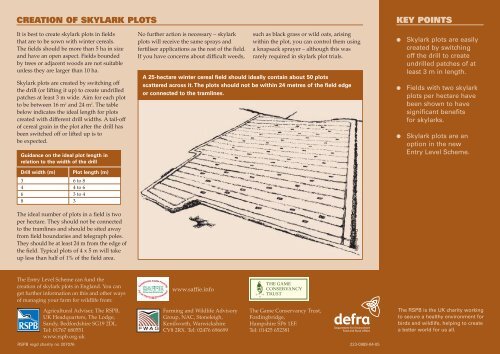Skylark plots - RSPB
Skylark plots - RSPB
Skylark plots - RSPB
Create successful ePaper yourself
Turn your PDF publications into a flip-book with our unique Google optimized e-Paper software.
CREATION OF SKYLARK PLOTS<br />
KEY POINTS<br />
It is best to create skylark <strong>plots</strong> in fields<br />
that are to be sown with winter cereals.<br />
The fields should be more than 5 ha in size<br />
and have an open aspect. Fields bounded<br />
by trees or adjacent woods are not suitable<br />
unless they are larger than 10 ha.<br />
<strong>Skylark</strong> <strong>plots</strong> are created by switching off<br />
the drill (or lifting it up) to create undrilled<br />
patches at least 3 m wide. Aim for each plot<br />
to be between 16 m 2 and 24 m 2 . The table<br />
below indicates the ideal length for <strong>plots</strong><br />
created with different drill widths. A tail-off<br />
of cereal grain in the plot after the drill has<br />
been switched off or lifted up is to<br />
be expected.<br />
Guidance on the ideal plot length in<br />
relation to the width of the drill<br />
No further action is necessary – skylark<br />
<strong>plots</strong> will receive the same sprays and<br />
fertiliser applications as the rest of the field.<br />
If you have concerns about difficult weeds,<br />
such as black grass or wild oats, arising<br />
within the plot, you can control them using<br />
a knapsack sprayer – although this was<br />
rarely required in skylark plot trials.<br />
A 25-hectare winter cereal field should ideally contain about 50 <strong>plots</strong><br />
scattered across it. The <strong>plots</strong> should not be within 24 metres of the field edge<br />
or connected to the tramlines.<br />
●<br />
●<br />
●<br />
<strong>Skylark</strong> <strong>plots</strong> are easily<br />
created by switching<br />
off the drill to create<br />
undrilled patches of at<br />
least 3 m in length.<br />
Fields with two skylark<br />
<strong>plots</strong> per hectare have<br />
been shown to have<br />
significant benefits<br />
for skylarks.<br />
<strong>Skylark</strong> <strong>plots</strong> are an<br />
option in the new<br />
Entry Level Scheme.<br />
Drill width (m)<br />
3<br />
4<br />
6<br />
8<br />
Plot length (m)<br />
6 to 8<br />
4 to 6<br />
3 to 4<br />
3<br />
The ideal number of <strong>plots</strong> in a field is two<br />
per hectare. They should not be connected<br />
to the tramlines and should be sited away<br />
from field boundaries and telegraph poles.<br />
They should be at least 24 m from the edge of<br />
the field. Typical <strong>plots</strong> of 4 x 5 m will take<br />
up less than half of 1% of the field area.<br />
Dan Powell<br />
The Entry Level Scheme can fund the<br />
creation of skylark <strong>plots</strong> in England. You can<br />
get further information on this and other ways<br />
of managing your farm for wildlife from:<br />
www.saffie.info<br />
Agricultural Adviser, The <strong>RSPB</strong>,<br />
UK Headquarters, The Lodge,<br />
Sandy, Bedfordshire SG19 2DL.<br />
Tel: 01767 680551<br />
www.rspb.org.uk<br />
Farming and Wildlife Advisory<br />
Group, NAC, Stoneleigh,<br />
Kenilworth, Warwickshire<br />
CV8 2RX. Tel: 02476 696699<br />
The Game Conservancy Trust,<br />
Fordingbridge,<br />
Hampshire SP6 1EF.<br />
Tel: 01425 652381<br />
The <strong>RSPB</strong> is the UK charity working<br />
to secure a healthy environment for<br />
birds and wildlife, helping to create<br />
a better world for us all.<br />
<strong>RSPB</strong> regd charity no 207076<br />
223-0989-04-05

















